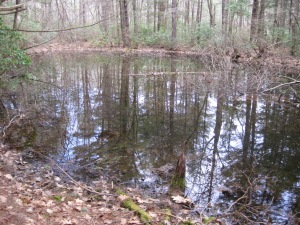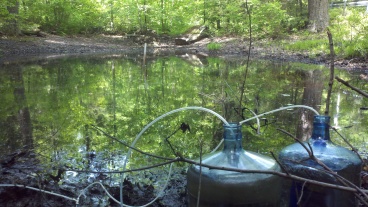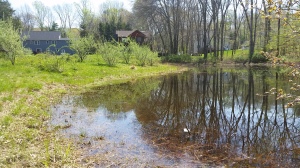Our research focuses on freshwater community and ecosystem ecology. We are interested in how organisms and ecosystem processes operate and interact, asking questions about nutrient and energy flow in food webs, carbon cycling and emissions, and how physical and chemical properties influence organisms. We also study how these dynamics respond to global environmental change, including climate and land use. To answer these questions we use field surveys, experiments, modeling, and global syntheses and collaborations.
Read more about our research projects below.
Freshwater Food Webs

A temporary pond in Connecticut
Freshwater ponds are biodiversity hotspots, but they face threats from environmental change (e.g., climate, land use, non-native species). Many of these stressors could disrupt pond food webs, with the potential to destabilize species interactions and ecosystem properties. To compound the issue, pond food webs are not well understood. There are debates over the extent to which terrestrial (e.g., leaves) vs. aquatic (e.g., algae) resources fuel food webs, and there are concerns over how non-native species or suburban nutrients could disrupt pond food webs. We study the structure of pond food webs and how they respond to disturbances.
Relevant publications:
Holgerson, M.A., M.R. Lambert, L.K. Freidenburg, and D.K. Skelly. 2018. Suburbanization alters small pond ecosystems: Shifts in nitrogen and food web dynamics. Canadian Journal of Fisheries and Aquatic Sciences 75: 641-652. Link
Holgerson, M.A., D.M. Post, and D.K. Skelly. 2016. Reconciling the role of terrestrial leaves in pond food webs: A whole-ecosystem experiment. Ecology 97: 1771-1782. Link
Freshwater Carbon Cycling

Drawing by Chai Rin Kim, Yale Daily News
Freshwaters play an important role in the global carbon budget as they both store and emit carbon. Our recent estimates suggest that inland waters collectively comprise up to 10-34% of global CH4 emissions (natural and anthropogenic combined). Our work shows that ponds have particularly high concentrations of both CO2 and CH4, and play a disproportionately large role in inland water carbon budgets relative to their size. The small and shallow nature of ponds can partially explain their high emissions: they have a high edge effect, meaning they are heavily influenced by the surrounding terrestrial environment (e.g., inputs of leaf litter, fertilizer), and they are shallow, meaning that decomposition at the bottom of the pond can influence much of the water column. Yet, emissions of pond greenhouse gases are understudied and quantifying pond carbon storage is a major research need. Our lab is part of several collaborations to improve estimates of inland water greenhouse gas emissions, with some projects specifically focused on ponds.
Relevant Publications:
Holgerson, M.A., E. Farr, and P.A. Raymond. 2017. Gas transfer velocities in small forested ponds. Journal of Geophysical Research – Biogeosciences 122: 1011-1021. Link
Holgerson, M.A., C.J. Zappa, and P.A. Raymond. 2016. Substantial overnight reaeration by convective cooling discovered in pond ecosystems. Geophysical Research Letters 43: 8044-8051. Link
Holgerson, M.A. and P.A. Raymond. 2016. Large contribution to inland water CO2 and CH4 emissions from very small ponds. Nature Geoscience 9: 222-226. Link
Holgerson, M.A. 2015. Drivers of carbon dioxide and methane supersaturation in small, temporary ponds. Biogeochemistry 124 (1): 305-318. Link

Measuring gas exchange rates in small ponds using a propane gas tracer.
Conservation and Management
Ponds provide critical habitat for unique flora and fauna, while also providing humans with important ecosystem services including water storage, nutrient filtration, groundwater recharge, and recreation. Yet, ponds are threatened by climate change (via altered nutrient loads, precipitation patterns, warming), development (both physically destroyed or developed around), altered hydrology (dammed, disconnected from rivers, used for stormwater), and non-native species. The Holgerson Lab has several projects to assess how humans modify pond communities and ecosystems. A central goal of ours is to inform better management practices and sustain ecologically resilient pond ecosystems into the future.

A suburban pond in Connecticut
Relevant publications:
Holgerson, M.A., A. Duarte, M. Hayes, M. Adams, J. Tyson, K. Douville, and A. Strecker. 2019. Floodplains provide important amphibian habitat despite multiple ecological threats. Ecosphere: e02853. Link
Holgerson, M.A., M.R. Lambert, L.K. Freidenburg, and D.K. Skelly. 2018. Suburbanization alters small pond ecosystems: Shifts in nitrogen and food web dynamics. Canadian Journal of Fisheries and Aquatic Sciences 75: 641-652. Link
Kolozsvary, M.B. and M.A. Holgerson. 2016. Creating temporary pools as wetland mitigation: How well do they function? Wetlands 36: 335-345. Link
PONDING (Pond Observation aNd Discovery in GLEON)
Our lab is involved with the Global Lake Ecological Observatory Network (GLEON). In 2017, Meredith founded and now co-leads a team called Pond Observation aNd Discovery in GLEON (PONDING). The goal of PONDING is to collaboratively explore how pond ecosystems function globally. We share research protocols and data, resulting in exciting projects and new ideas. PONDING currently includes three global projects focused on pond ecosystems: (1) pond mixing patterns, (2) pond carbon emissions, and (3) pond ecosystem metabolism. We’re also tackling a fourth project to answer everyone’s favorite question: What is a pond?!


